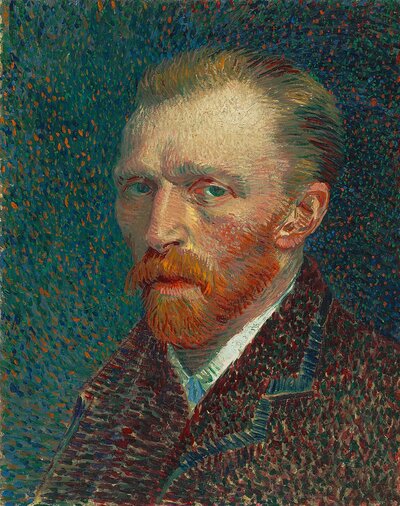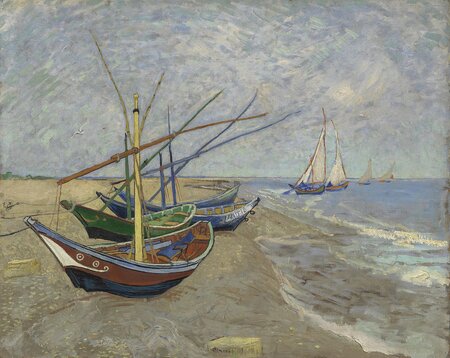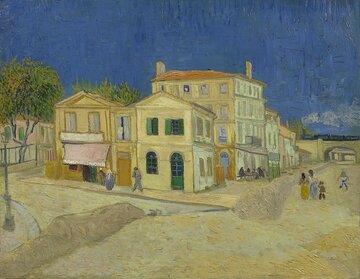Vincent van Gogh
|
|
Vincent Willem van Gogh (March 30, 1853–July 29, 1890) was a Dutch painter, generally considered one of the greatest painters in European art history. He produced all of his work (some 900 paintings and 1100 drawings) during a period of only ten years before he succumbed to mental illness (possibly bipolar disorder) and committed suicide. He had little success during his lifetime, but his posthumous fame grew rapidly, especially following a showing of 71 of van Gogh's paintings in Paris on March 17, 1901 (11 years after his death).
Van Gogh's influence on expressionism, fauvism and early abstraction was enormous, and can be seen in many other aspects of 20th-century art. The Van Gogh Museum in Amsterdam is dedicated to Van Gogh's work and that of his contemporaries. The Kroller-Muller Museum in Otterlo (also in the Netherlands), has a considerable collection of Vincent van Gogh paintings as well.
Several paintings by Van Gogh rank among the most expensive paintings in the world. On March 30, 1987, van Gogh's painting Irises was sold for a record US$53.9 million at Sotheby's; on May 15, 1990, his Portrait of Doctor Gachet was sold for $82.5 million at Christie's, thus establishing a new price record.
| Contents |
Life and work
Vincent was born in Zundert, the son of Anna Cornelia Carbentus and Theodorus van Gogh, a Protestant minister. Van Gogh found his father's profession appealing and would be drawn to it later in his life. His sister described him as serious and introspective.
At age 16, van Gogh started to work for the art dealer Goupilator & Company in the Hague. His brother Theo, four years his junior and with whom Vincent cherished a lifelong friendship, would join the company later. This friendship is amply documented in the large collection of letters they sent each other. These letters have been preserved and were published in 1914. They provide much insight into the life of the painter, and show him to be a talented writer with a keen mind. Theo would support Vincent financially throughout his life.
In 1873, his firm transferred him to London, then to Paris. He became increasingly interested in religion; in 1876, Goupil dismissed him for lack of motivation. He became a teaching assistant in Ramsgate in Kent, England, then returned to Amsterdam to study theology in 1877.
After dropping out in 1878, he became a lay minister in Belgium in a poor mining region known as the Borinage. He even preached down in the mines and was extremely concerned with the lot of the workers. He was dismissed after six months and continued without pay. During this period he started to produce charcoal sketches.
In 1880, Vincent followed the suggestion of his brother Theo and took up painting in earnest. For a brief period, Vincent took painting lessons from Anton Mauve at the Hague. Although Vincent and Anton soon split over a divergence of artistic views, influences of the Hague School of painting would remain in Vincent's work, notably in the way he played with light and in the looseness of his brush strokes. However, his usage of color, favoring dark tones, set him apart from his teacher.
In 1881, he declared his love to his widowed cousin Kee Vos, who rejected him. Later he would move in with the prostitute Sien Hoornik and her children and considered marrying her; his father was strictly against this relationship and even his brother Theo advised against it. They later separated.
Impressed and influenced by Jean François Millet, van Gogh focused on painting peasants and rural scenes. He moved to the Dutch province Drenthe, later to Nuenen, North Brabant, also in The Netherlands. Here he painted in 1885 The Potato Eaters (Dutch Aardappeleters, now in The Van Gogh Museum in Amsterdam).
In the winter of 1885–1886, Van Gogh attended the art academy of Antwerp. This proved a disappointment, as he was dismissed after a few months by Professor Eug�ne Siberdt. Van Gogh did, however, become familiar with Japanese art during this period, which he started to collect eagerly. He admired its bright colors, use of canvas space and the role lines played in the picture. These impressions would influence him strongly. Van Gogh made some paintings in Japanese style. Also some of the portraits he painted are set against a background which shows Japanese art.
In spring 1886, Van Gogh went to Paris, where he moved in with his brother Theo; they shared a house on Montmartre. Here he met the painters Edgar Degas, Camille Pissarro, Emile Bernard, Henri de Toulouse-Lautrec and Paul Gauguin. He discovered impressionism and liked its use of light and color, more than its lack of social engagement (as he saw it). (It should be noted that Van Gogh is regarded as a post-impressionist, rather than an impressionist.) He especially liked the technique known as pointillism (where many small dots are applied to the canvas that blend into rich colors only in the eye of the beholder, seeing it from a distance) made its mark on Van Goghs own style. Van Gogh also used complementary colors, especially blue and orange, in close proximity in order to enhance the brilliance of each. A lovely quote from one of his letters: "I want to use colors that complement each other, that cause each other to shine brilliantly, that complete each other like a man and a woman."
In 1888, when city life and living with his brother proved too much, Van Gogh left Paris and went to Arles, Bouches-du-Rhine, France. He was impressed with the local landscape and hoped to found an art colony. He decorated a "yellow house" and created a celebrated series of yellow sunflower paintings for this purpose. Only Paul Gauguin, whose simplified color schemes and forms (known as synthetism) attracted van Gogh, followed his invitation. The admiration was mutual, and Gauguin painted van Gogh painting sunflowers. However their encounter ended in a quarrel. Van Gogh suffered a mental breakdown (possibly induced by absinthe) and cut off part of his left ear, which he gave to a startled prostitute friend. Gauguin left in December 1888.
One of Vincent's famous paintings, the Bedroom in Arles, uses bright yellow and unusual perspective effects in depicting the interior of his bedroom. The boldly vanishing lines are sometimes attributed to his changing mental condition. The only painting he sold during his lifetime, The Red Vineyard, was created in 1888. It is now on display in the Pushkin Museum in Moscow, Russia.
Van Gogh now exchanged painting dots for small stripes. He suffered from depression, and in 1889 on his own request Van Gogh was admitted to the psychiatric center at Monastery Saint-Paul de Mausole in Saint Remy de Provence, Bouches-du-Rh�ne, France. During his stay here the clinic and its garden became his main subject. At this time his work began to be dominated by swirls. This is especially shown in his most famous painting, The Starry Night.
In May 1890, Vincent left the clinic and went to the physician Paul Gachet, in Auvers-sur-Oise near Paris, where he was closer to his brother Theo, who had recently married. Gachet had been recommended to him by Pissarro; he had treated several artists before. Here van Gogh created his only etching: a portrait of the melancholic doctor Gachet. His depression deepened, and on July 27, at the age of 37, van Gogh shot himself in the chest. Without realizing that he was fatally wounded, he returned to the Ravoux Inn, where he died two days later, with Theo at his side, who reported his last words as "La tristesse durera toujours" (French for "the sadness will last forever"). He was buried at the cemetery of Auvers-sur-Oise; Theo, unable to come to terms with his brother's death, died six months later and, at his wife's request, was buried next to Vincent. While many have mistakenly thought that Wheat Field with Crows was van Gogh's last work before his suicide (because of its turbulent style), it is more likely that van Gogh's last work was Daubigny's Garden.
It would not take long before van Gogh's fame grew higher and higher. Large exhibitions were organized soon: Paris (1901), Amsterdam (1905), Cologne (1912), New York City (1913) and Berlin (1914).
Van Gogh's life forms the basis for Irving Stone's biographical novel Lust for Life.
Interesting Facts
- Vincent van Gogh was born on March 30, 1853, and he died on July 29, 1890
- created about 2,100 artworks, including around 860 oil paintings
- his distinct style featured bold, dramatic brush strokes
- famously cut off his own ear after a heated argument with fellow artist Paul Gauguin in December 1888
Notable Works
- (1885) The Potato Eaters [1] (http://www.vangoghgallery.com/painting/p_0082.htm)
- (1888) Bedroom in Arles [2] (http://www.vangoghgallery.com/painting/p_0484.htm)
- (1888) Cafe Terrace at Night [3] (http://www.vangoghgallery.com/painting/p_0467.htm)
- (1888) The Red Vineyard [4] (http://www.vangoghgallery.com/painting/p_0495.htm)
- (1889) The Starry Night [5] (http://www.vangoghgallery.com/painting/p_0612.htm)
- (1889) Irises † [6] (http://www.vangoghgallery.com/painting/p_0608.htm)
- (1889) Still Life: Vase with Twelve Sunflowers [7] (http://www.vangoghgallery.com/painting/p_0455.htm)
- (1889) Portrait de l'artiste sans barbe † [8] (http://www.vangoghgallery.com/painting/p_0525.htm)
- (1890) Portrait of Doctor Gachet † [9] (http://www.vangoghgallery.com/painting/p_0754.htm)
- (1890) Wheat Field with Crows [10] (http://www.vangoghgallery.com/painting/p_0779.htm)
† Denotes paintings which are recent recordholders for the highest price paid for a painting at an auction.
Influences on van Gogh
(see also above)
- The Hague School.
- Painter Jean-Francois Millet (1814 – 1875), who also focused on peasant life.
- Writer Emile Zola (1840 – 1902) whose novels Van Gogh admired.
- Japanese woodblock prints (Japonisme).
- Impressionism, notably pointillists Georges Seurat (1859 – 1891) and Paul Signac (1836 – 1935).
- Paul Gauguin (1848 – 1903).
References
- Complete Letters of Vincent Van Gogh, Vincent van Gogh, Bulfinch, 2000, ISBN 0821226304.
External links
- Van Gogh Museum (http://www.vangoghmuseum.nl), Amsterdam, The Netherlands.
- National Gallery of Art (http://www.nga.gov/exhibitions/vgwel.shtm), Washington D.C., United States — A virtual tour of the Van Gogh's Van Goghs exhibition.
- The Vincent Van Gogh Gallery (http://www.vggallery.com) — Commercial site showing all of Vincent van Gogh's works and letters.
- Van Gogh's Letters (http://webexhibits.org/vangogh/) — unabridged & annotated exhibit.




